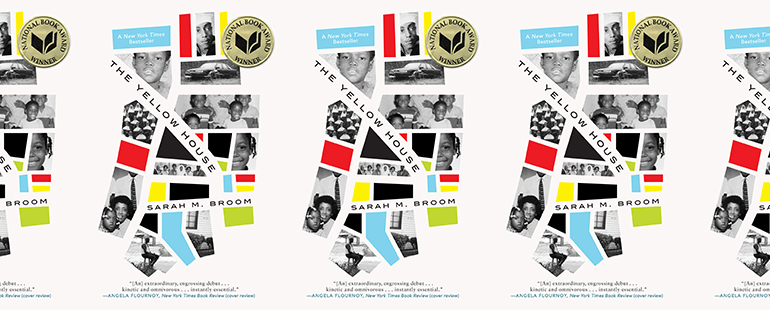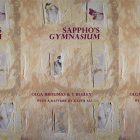The Grounding Power of the Past

Early on in Sarah M. Broom’s The Yellow House, she mentions that a relative thinks “the past played tricks [while] the present was a created thing.” Of course, you can’t create in the present without the grounding of the past, no matter how tricky that grounding may be. So Broom tries to flesh out a more promising future for herself and her family by understanding the grounding of her past, by creating writings and recordings of stories that happened in her family’s old home, the “Yellow House,” building up a book of a torn down house to preserve their old home. She wants to reconstruct not the house itself, but the neighborhood she grew up in, their community, their home. She wants to reconstruct lives lost, both before, during, and after the destruction of their home.
Of course, not everyone in Broom’s family sees the importance of looking back to preserve painful pasts. When she contacts her oldest brother, Simon, to tell him about her work, “he expresses worry that by writing this all down here, [she] will disrupt, unravel, and tear down everything the Broom family has ever built. He would like, now, to live in the future and forget about the past. ‘There is a lot we have subconsciously agreed that we don’t want to know.’” Broom responds that she wants to write about “architecture.” This is a deflection, pretending the journey ends at the physical components of a house, and not the emotional characteristics of a home. Yes, she wants to study the architecture of the Yellow House, but beyond the architecture of the physical house, she’s also interested in the architecture of their home. Studying the house is an avenue to study and tell the stories and histories of her family. The Yellow House was destroyed by the city of New Orleans right after the Federal Floods that followed Hurricane Katrina—“The house was displaced from its foundation”; the only way to preserve their life and the home that was grounded within the walls of the Yellow House is to dig deep.
The first image we get in The Yellow House is an aerial view of the Broom family’s land, which Broom describes as “a scab of green.” Broom sees the scab as ready to be studied and learned from, exploring the hurts and loves of the past in order to build something in the present, for the future. She wants to make a physical record of these stories, to have something to show herself, her mother, her family, that contains their stories within it. But some of her family members think that picking the scab of green would just reveal an open wound, one that would get infected and hurt and never heal if not left alone. There are some things, whether rumors of children born out of wedlock, or stories of drug addiction, the death of their father, or the stories of the destruction of the house, that members of the family don’t want to revisit, the price not being worth the purchase. But Broom writes from this aerial view because she can’t unsee the scab of green where the Yellow House used to be, because she can’t unsee her brother Carl rooted in that naked ground. Broom thinks about the remnants of their home, how “The table where Carl sometimes sits is on the spot where our living room used to be but where instead of floor there is green grass trying to grow.” Carl sits where the living room used to be, no signs of the living beside him, wondering whether the grass would grow, as Broom wonders where the histories and stories of the past will go. Broom states that “writing is interiority.” All Broom has is interiority, so she thinks about Carl, who spends time at the land, where Broom herself can’t always be.
What Broom is writing, is preserving, what she is creating in the present, is important, for it’s steeped in the histories, in the stories, in the hurt of the family. She tries to convey that hurt by asking the reader to imagine her street being “dead quiet, and you lived on those dead quiet streets, and there is nothing left of anything you once owned.” The street may be dead quiet, and their father, who built and repaired so much of that house, may have passed, but still her brother watches over the land, and she watches over him, writing it all down. And without the both of them, this could all be lost. Broom writes of how “The facts of the world before me inform, give shape and context to my own life. The Yellow House was witness to our lives. When it fell down, something in me burst.” The Yellow House witnessed the Broom’s family life, so now Broom wants to witness the life of the Yellow House, and see what information and stories she can find in whatever remains, rebuilding the story of the family so they can all be together again.
Broom was born in the Yellow House, which is also the house her father died in. The fact that her father died six months after Broom was born means those events are inextricably linked. So Broom tries to understand and comprehend what the loss of a home does for a family. So Broom searches for information about their father, trying to understand the man behind all the incomplete projects within the house, the ones that will never be completed now that both the house and he are gone. The Yellow House was the tentpole that the family was tethered to. Broom’s brothers and sisters, and her mother’s brothers and sisters, always orbited this house, entered the atmosphere of the home, until it wasn’t there anymore. So Broom tries to navigate those stories to get a grounding on their home. At the end of her book’s Acknowledgements, Broom writes to someone that there is “No home absent you.” There is no home without the people you love. And there is no happy story without a home for you and the people you love. The fact that so little is written about the neighborhood the Yellow House was built in, New Orleans East, makes it all the more important for her to flesh out the story of her old home: there is no past, not even tricky grounding, for her to rely on. She has to create her own canon. And that requires her exploring her past, and writing the stories and histories down.
The book starts off with the history of the family, relying mostly on written records and oral stories to talk about generations ago. Once we get to the destruction of the Yellow House, Broom herself is old enough to be able to focus mostly on her. The book goes from reporting on people of whom only “scratchings are known” to Broom telling stories about her own life (or her brothers that were there during the flood) directly to the readers. She goes to Burundi to work at a radio station, recording people’s stories as she takes notes on exile and displacement. She learns from these stories, widening and clarifying the lens of exile and displacement, and gaining a better understanding of what happened to her family in the process. Gaining grounding on her tricky past.
But being away keeps her distanced from her family, which means their stories stop for her, like how a distant river seems still. So she goes to see her family that scattered all over the United States after the Yellow House was destroyed. She writes that she took this trip to seek “literal grounding in the people who confirmed and composed crucial parts of my identity.” She needed to be grounded before she could stand on the ground of the Yellow House and continue to write the stories. She needed to conjure up the histories, and flesh them out with the peoples that had been frozen in time for her.
Part of the struggle of the Yellow House is that, with no house to see, the stories of the house freeze too. While Broom knows where the house was, for example, she struggles to find the resting place of a neighborhood friend, Alvin. Alvin was the first kid to kiss her, though as they grew up, they started to grow apart. When Alvin died, his story on earth ended, but Broom keeps thinking about him. When she returns after the floods, after the Yellow House has been destroyed, she asks Alvin’s sister about where his headstone is so she can pay her respects, and so she has something physical to help her conjure thoughts of him, like a totem. But Alvin’s sister tells Broom that Alvin doesn’t have a headstone. Broom tries to find the plot of land that he is buried in, while at the same time her brothers ask her to help their mother with their application for the Road Home Program, a HUD-funded program that was supposed to assist homeowners who were affected by the Federal Floods. They want to get something built on the land, or to get paid for the land, where the Yellow House once stood. Broom continues to look in the past while trying to help her mother and brothers create something for the future. She continues to work toward having a physical record of their stories, of their home, that they could hold in their hands.
The importance of having that physical entity to gravitate to, for the emotional, mental, and spiritual aspects of home, is key; Broom writes, “The house held my father inside of it, preserved; it bore his traces. As long as the house stood, containing these remnants, my father was not yet gone. And then suddenly, he was.” In a way, the Yellow House is a headstone for the father. Broom wants to research and record more and more of the tricky past that the Yellow House was built on. She looks up archival footage of her father’s band to see if she can see the man from the pictures, to see how seeing him move would affect her, just like how she imagines Carl and the dead streets after the Yellow House was destroyed, just like how she researches more and more about New Orleans East and the Yellow House, writing and recording histories and stories about the land and the family. Meanwhile, some of her brothers want the chapter to be closed, with either a new house or getting paid for the land. Everyone looked for a kind of headstone for the father, for the Yellow House, for their home, something physical to gravitate to, something to touch and clean and morph with their hands, instead of an abstract thing left to slowly dissipate due to dismemory. Just like when Broom and her brothers and sisters used to crawl into their mother’s bed, just after their father had passed, to lie in the spot that he used to rest in, hoping to capture some leftover warmth now that he rested somewhere else. The gravitational pull of the physical is a placeholder for the mental, emotional, and spiritual work that this book, these stories, are doing.
Early in the book, Broom writes, “My mother is always saying, Begin as you want to end. But my beginning precedes me.” Which is why we started out with Carl looking over their lot, nothing else but grass there. Which is why we go through the stories of generations before her, before the Yellow House even, to understand Broom’s story, to understand her home’s story. And this is why we watch as Broom sits and watches and imagines this place she grew up in, and researched about, and wrote about. At the end of the book, we see Carl mowing the lawn on their land. When Broom goes with him to get the lawnmower, she realizes she is doing that not just to keep up their land, the land they don’t live on anymore, but to see their land the way Carl sees it. Broom mows the lawn, an act like resting flowers on a headstone, to beautify a thing that’s past, but isn’t passed them yet.
The ground may be tricky, but being rootless was tragedy. Broom writes, “As long as we had the ground, I took it to mean, we were not homeless, which was Carl’s definition of tragedy.” But it is not being houseless that is a tragedy, it is being homeless. And Carl guards whatever home they have left there, while Broom creates writings and recordings of their tricky past, of the grounding that they are creating a sense of home out of.
Broom may not be able to physically rebuild the Yellow House, just like she can’t consistently be in a house with all her brothers and sisters and their mother, and just like how their stories in some ways will freeze, due to that disconnect. But, while writing may be “interiority,” Broom has created a physical entity in her book, which digs deep into the ground, into the tricky past. The scab picked, the scar revealed, for her community, her family, herself, to carry, the stories and the family all in one place, together again, in a home of a book.



